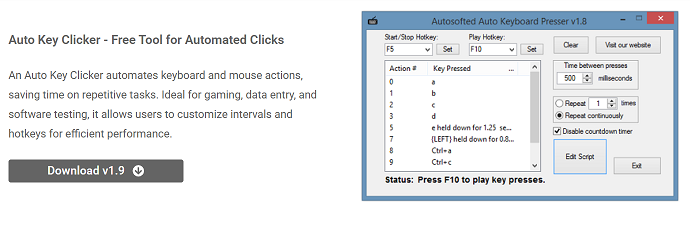Automation tools have become essential for enhancing efficiency in repetitive computer tasks. AutoKeyClicker is a popular program known for automating mouse clicks, but many users wonder if it also supports keyboard automation. This feature would be valuable for those needing to automate keystrokes in addition to mouse actions.
Keyboard automation can save time and reduce physical strain, especially for tasks that require frequent typing or shortcut commands. Understanding whether AutoKeyClicker handles keyboard input is crucial for users considering it for diverse automation needs. This article explores AutoKeyClicker’s keyboard automation capabilities in detail.
We will examine how the tool supports keystrokes, explore customization options, and discuss practical use cases. This insight will help you decide if AutoKeyClicker meets your automation requirements.
AutoKeyClicker and Keyboard Automation Basics
Overview of Keyboard Automation
Keyboard automation involves programming the tool to simulate key presses automatically. This allows repetitive typing tasks, shortcut execution, or command inputs to run without manual intervention. It increases speed and reduces errors in tasks requiring frequent keyboard use.
AutoKeyClicker’s Automation Capabilities
AutoKeyClicker primarily automates mouse clicks but also supports basic keyboard automation. Users can configure it to simulate keystrokes in conjunction with mouse clicks. This dual functionality expands its usefulness for complex workflows requiring mixed inputs.
Supported Keystroke Types
The tool can simulate single key presses, key holds, and combinations like Ctrl+C or Alt+Tab. This covers the most common shortcut commands and typing needs. Flexibility in keystroke simulation allows diverse automation scenarios.
Keyboard Automation in AutoKeyClicker
Configuring Keystroke Commands
Users enter the desired keys or combinations into AutoKeyClicker’s settings. The tool allows specifying the exact keys to press and how long to hold them. This customization ensures precise control over keyboard automation.
Timing and Repetition Settings
You can adjust the interval between simulated key presses and how many times the sequence repeats. This timing control is crucial for aligning automation speed with the task’s requirements. Proper timing prevents errors or missed inputs.
Using Hotkeys for Control
AutoKeyClicker lets you assign hotkeys to start, pause, or stop keyboard automation quickly. These shortcuts offer convenient control without requiring navigation through menus. Hotkeys improve workflow flexibility and responsiveness.
- Customize keystroke commands easily
- Adjust timing and repetition precisely
- Control automation with hotkeys
Practical Uses of Keyboard Automation
Automating Data Entry
Keyboard automation can speed up repetitive typing tasks like entering forms or filling spreadsheets. AutoKeyClicker allows users to simulate typing sequences, reducing manual workload. This improves accuracy and efficiency in data-heavy tasks.
Executing Shortcut Commands
Many software tasks involve repeated use of keyboard shortcuts. Automating these commands with AutoKeyClicker saves time and reduces strain. It’s particularly useful in editing, programming, or graphic design workflows.
Supporting Gaming Actions
Some games require frequent key presses or complex combos. AutoKeyClicker’s keyboard automation helps gamers perform these inputs consistently and effortlessly. This reduces fatigue and enhances performance during long sessions.
Limitations of AutoKeyClicker’s Keyboard Automation
Basic Functionality Compared to Dedicated Tools
While AutoKeyClicker supports keyboard automation, its features are more basic than specialized keyboard macro software. It lacks advanced scripting or conditional commands. Users needing complex automation might require more powerful tools.
Compatibility Issues with Some Programs
Certain software or games may block or not recognize simulated keystrokes from AutoKeyClicker. This can limit its effectiveness in those environments. Testing compatibility before relying on automation is recommended.
User Interface Simplicity
AutoKeyClicker’s interface for keyboard automation is straightforward but lacks advanced customization options. This simplicity is good for beginners but might frustrate advanced users. The tool balances ease of use with limited features.
Tips for Effective Keyboard Automation
Plan Your Automation Workflow
Before setting up, outline the keystrokes and sequences you want to automate. This planning helps create efficient automation scripts and avoid errors. A clear plan ensures a smoother automation setup.
Test Settings Thoroughly
Run tests to confirm that keyboard automation behaves as expected. Verify timing, repetition, and key accuracy. Testing prevents mistakes during full automation and improves reliability.
Combine Mouse and Keyboard Automation
Use AutoKeyClicker’s ability to automate both clicks and keystrokes together for more comprehensive workflows. Combining these inputs enhances task automation and reduces manual effort. This hybrid approach maximizes productivity.
Keyboard Automation in AutoKeyClicker
Time-Saving Benefits
Automating keystrokes cuts down the time spent on repetitive typing or shortcut use. This time saving accumulates over long sessions, significantly boosting productivity. It also reduces the chance of human error.
Reducing Physical Strain
Simulating keyboard input lessens the repetitive motion that can cause strain or injury. AutoKeyClicker helps protect users from fatigue and discomfort during extended tasks. This promotes healthier computing habits.
Easy to Learn and Use
AutoKeyClicker’s keyboard automation is accessible for beginners due to its simple interface. Users do not need programming knowledge to automate keystrokes. This ease of use lowers the barrier to automation.
- Saves time on typing and shortcuts
- Reduces repetitive strain injuries
- Beginner-friendly interface
Keyboard Automation Enhances Productivity
Improving Workflow Efficiency
Automated keystrokes streamline repetitive tasks, allowing you to complete them faster and with fewer mistakes. This frees up time for creative or strategic work, enhancing overall efficiency.
Enabling Multitasking
With AutoKeyClicker handling keyboard inputs, you can focus on other tasks simultaneously. This multitasking capability optimizes time use and balances workloads effectively.
Supporting Consistency in Tasks
Consistent keystroke timing and accuracy improve the quality of repetitive processes. Automation ensures tasks are performed identically every time, which is crucial for data integrity and testing.
Conclusion
AutoKeyClicker supports keyboard automation by simulating keystrokes in conjunction with mouse clicks, thereby expanding its utility. While its keyboard features are basic compared to specialized tools, it covers most common needs effectively. Users benefit from time savings, reduced physical strain, and improved workflow efficiency. Proper setup and testing ensure reliable automation. This makes AutoKeyClicker a practical choice for those seeking combined mouse and keyboard automation.



